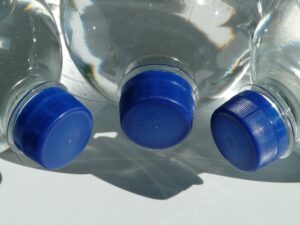
You can protect your products with tamper-evident packaging including closures with tamper rings.
Tamper-Evident Packaging has not always been around. Before the infamous Tylenol incident of the 1980s where several bottles were illegally contaminated, tamper-evident packaging was not in vogue.
They Tylenol crisis inspired the packaging industry to develop tamper-evident packaging methods that prevents unwanted containment with products.
Tamper-Evident Packaging
Now, decades later, tampering technology continues to evolve. Today’s tamper-evident packaging is often stylish and subtle, as well as impressively innovative. Tamper-evident packaging is crucial for food, beverage, pharmaceutical, and cosmetic products. Tamper-evident packages reassure consumers that their product is safe and untouched. There are various ways in which tamper-evident packaging has evolved; read on for a few common examples.
Heat Shrink Bands
These tamper-evident tools are small pieces of plastic shrink-wrapped over the opening of a package, often the neck and lid portion of a jar or bottle. Alternatively, some shrink bands could wrap around the entire piece. The bands must be torn away for the product to be opened for the first time, and they cannot return to their original sealed appearance.
Shrink bands are fast and easy and quickly alert customers to the product’s integrity. They are safe to use with any product and are cost-efficient as they are cheaper per unit than other tamper-evident packaging.
These bands come in various sizes and must be measured specifically to a container and closure combination for best performance. Because these closures do not adhere to the package, the package works best with bottles that have a protruding “lip” at the neck of the bottle.
Closures with Tamper Evident Ring
Closures are tamper-evident packaging that involves a cap connected to a breakable ring. These closures are designed to take advantage of a tamper bead added directly to the bottle during production. When the consumer twists off the closure, the cap breaks off from the bottom ring. If the closure and ring are already disconnected, this signifies tampering. Dairy products, water, and juice products utilize closures the most.
Bottle components must be designed to accept tamper-evident closures. If you have to modify your existing molds to accommodate tamper-evident closures, it may be time-consuming.
Heat Induction Seals
These seals protect the purity of the content during shipping and storage and alert people to tampering. A heat induction seal provides extra strength and security to the bottle’s closure. When consumers open the package, they tear away the seal to access the product. The liner will not reseal once it has been removed. This type of tamper-evident packaging is often used in the pharmaceutical industry.
The liner materials must first be tested to ensure proper adhesion to the bottle. The liner is a product-facing material, so it must also be tested to ensure compatibility with your product. Finally, special machinery is required to apply heat induction liners with a proper seal.
Decorative Labels
This form of tamper-evident packaging is the most stylish. These labels adhere directly to a package’s lid and create a seal that must be broken to open the package.
These labels can be printed on paper stock or tamper-evident stock with creative colors and designs that complement the secondary packaging. These have gained popularity in the cosmetics industry, as these labels provide a stylish aesthetic that can match well with existing cosmetic packaging. These labels are often also used in the liquor industry. If the decorative labels are removed, they will also leave behind some residue that does not permit resealing.
Liquid Filling Experts
For over 70 years, FILAMATIC has provided a wide range of liquid filling machines to the packaging market. We create flexible, customized solutions for every stage of your business growth. Whether you require a single machine, a complete turnkey solution, or a fully-automated, integrated Monobloc system, we have the liquid filling experience that will exceed your expectations.
For more information on liquid filling, capping and labeling solutions, please call 866.258.1914 or visit – www.filamatic.com/contact-us.
